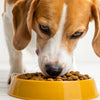How Much Water Should You Put in Dry Dog Food? Enhancing Your Dog's Meal Experience
- Houndsy
Table of Contents
- Introduction
- The Importance of Hydration in Dog Nutrition
- Benefits of Mixing Water with Dry Dog Food
- Best Practices for Mixing Water with Dry Dog Food
- Addressing Common Concerns
- Conclusion
Introduction
As devoted pet owners, we always want the best for our furry companions. Did you know that nearly 60% of dog owners report their pets are picky eaters? This statistic highlights a common concern among us: how to encourage our dogs to eat their meals enthusiastically. One popular method is mixing water with dry dog food, but is this practice truly beneficial?
In this blog post, we will explore the implications of mixing water with dry dog food, examining its effects on hydration, digestion, palatability, and overall pet health. By the end, you'll have a comprehensive understanding of whether or not to adopt this practice for your dog and how it can fit into your feeding routine. We’ll also reflect on our own feeding experiences and consider how our beloved pets react to different feeding strategies. So, let’s dive in and discover the truth behind this popular approach to dog feeding!
The Importance of Hydration in Dog Nutrition
Just as we need water to thrive, our dogs do too. Hydration is crucial for maintaining energy levels, supporting bodily functions, and promoting overall health. Veterinary nutritionists emphasize that hydration can directly impact a dog's digestion and nutrient absorption. When dogs consume dry food, they may not drink enough water to make up for the moisture content that is missing from their diet. This can lead to various health issues, including urinary problems and digestive disturbances.
Signs of Dehydration in Dogs
It's important to be able to recognize the signs of dehydration in dogs. Some common symptoms include:
- Lethargy: A decrease in energy levels or unusual tiredness.
- Dry gums: Gums that appear dry or sticky instead of moist.
- Loss of appetite: If your dog is not interested in food, it may be a sign of dehydration.
- Sunken eyes: Eyes that appear sunken or dull can indicate dehydration.
- Skin elasticity: Skin that doesn't bounce back when gently pulled can be a signal of dehydration.
If you notice any of these signs in your dog, it’s crucial to address their hydration needs promptly.
Benefits of Mixing Water with Dry Dog Food
Adding water to dry dog food can offer several advantages that enhance your pet's overall health and well-being. Here are some key benefits to consider:
1. Enhanced Palatability
One of the most significant advantages of adding water to dry dog food is the improvement in palatability. Dogs are instinctively drawn to food that is aromatic and flavorful, and adding water can unlock the scent and enhance the taste of their kibble. This is especially beneficial for dogs that may be hesitant to eat dry food or those that have lost interest in their meals.
2. Improved Digestion
When dry food is moistened, it softens the kibble, making it easier for your dog to chew and swallow. This can be particularly helpful for older dogs or those with dental issues who may struggle to eat dry kibble comfortably. Furthermore, the increased moisture can assist in breaking down food in the digestive tract, leading to better nutrient absorption.
3. Increased Hydration
Adding water to dry dog food is an effective way to boost your dog’s overall hydration levels. This is especially important for dogs that may not drink enough water throughout the day. By incorporating moisture directly into their meals, we can help promote healthier urinary function and support kidney health, reducing the risk of urinary tract infections and kidney stones.
4. Weight Management
If you're monitoring your dog's weight, mixing water with dry kibble can be a strategic move. Soaking the kibble increases its volume without adding calories, which can help your dog feel fuller while consuming fewer calories. This can be particularly beneficial for dogs that are prone to overeating or those that require weight management.
5. Slower Eating
For dogs that tend to gulp their food, adding water can help slow down mealtime. This can reduce the risk of bloating and gastrointestinal discomfort, as well as encourage your dog to chew their food more thoroughly. In turn, this promotes better digestion and nutrient absorption.
Best Practices for Mixing Water with Dry Dog Food
While adding water to your dog's kibble can be beneficial, it’s essential to find the right balance. Here are some best practices to consider when mixing water with dry dog food:
Choosing the Right Amount of Water
A general guideline is to add enough water to moisten the kibble without making it overly soggy. Start with a small amount, such as ¼ to ½ cup of water per cup of kibble, and adjust according to your dog's preferences.
Timing Matters
To maximize the benefits, consider soaking the kibble for a short period—typically 15 to 30 minutes—before serving. This allows the kibble enough time to absorb the water while maintaining its structure. However, avoid letting the moistened kibble sit out for too long, as this can promote bacterial growth. If your dog doesn’t finish their meal, make sure to discard any leftover food within 30 minutes.
Monitoring Your Dog's Reaction
Every dog is unique, and their response to watered kibble may vary. After introducing this change, observe your dog's eating habits and overall health. If they seem to enjoy their meals more and show improved hydration, you may have found a winning strategy!
Addressing Common Concerns
One common question that arises is whether adding water to dry dog food affects its nutritional value. Generally, the act of hydrating kibble does not destroy nutrients. However, be cautious not to use boiling water, as high temperatures can potentially damage some vitamins. Instead, opt for warm water or room temperature water when soaking kibble.
Is Soaking Kibble Safe for Dogs with Specific Health Issues?
If your dog has specific health concerns, such as pancreatitis, it’s best to consult your veterinarian before altering their diet. Some dogs may require special dietary considerations, and a vet can provide personalized advice based on your pet’s health needs.
Quality Matters
While mixing water with kibble is beneficial, it’s still essential to ensure that the kibble itself is of high quality. Look for products that contain real meat, wholesome grains, and minimal fillers. At Houndsy, we prioritize quality and functionality in our products, including our flagship Houndsy Kibble Dispenser, designed to provide perfect portion control while complementing modern home decor. Explore our Houndsy Kibble Dispenser to elevate your dog feeding experience.
Conclusion
In conclusion, mixing water with dry dog food can be a beneficial practice for many dogs, improving palatability, digestion, hydration, and overall health. However, it’s essential to monitor your dog’s reaction, adjust the water quantity as needed, and ensure that you’re feeding high-quality kibble. By adopting this approach, we can elevate our pets' feeding experience, making mealtime more enjoyable and healthful.
As responsible pet owners, let’s continue to explore innovative ways to care for our furry friends. Have you tried adding water to your dog's food? Share your experiences and tips with us, and don’t hesitate to check out the Houndsy Kibble Dispenser for a convenient and stylish feeding option!
FAQ
- How much water should I add to my dog's dry food? A good starting point is to add ¼ to ½ cup of water per cup of kibble. Adjust the amount based on your dog's preferences.
- Can I use boiling water to soak the kibble? It’s best to avoid boiling water, as high temperatures can damage some nutrients. Use warm or room temperature water instead.
- Will adding water to kibble help my picky eater? Yes! Adding water can enhance the flavor and aroma of the kibble, making it more appealing to picky eaters.
- How long should I soak the kibble? Soak the kibble for about 15 to 30 minutes before serving to allow for optimal hydration without becoming overly soggy.
- Is it safe to leave moistened kibble out for an extended period? No, it’s best to discard any uneaten moistened kibble after 30 minutes to prevent bacterial growth.
- Are there any specific health conditions that require consulting a vet before adding water to kibble? Yes, if your dog has specific health concerns, such as pancreatitis, consult your veterinarian for personalized advice before altering their diet.












